November 11, 2009
Churchill
The pictures say it all. Another amazing day in Churchill.
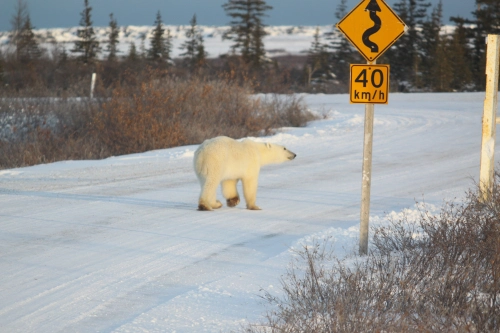
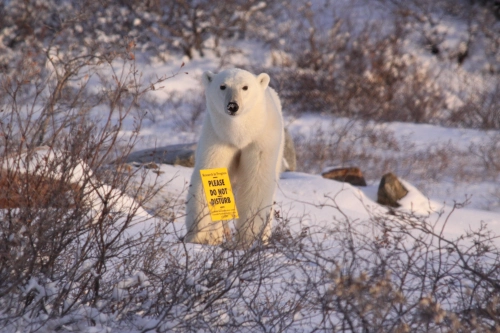
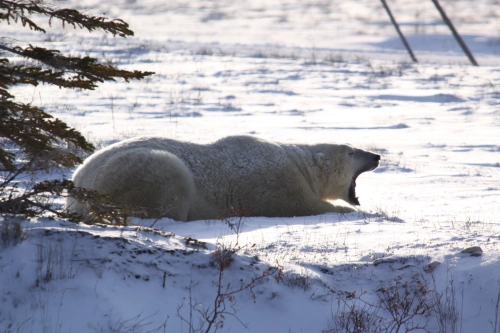
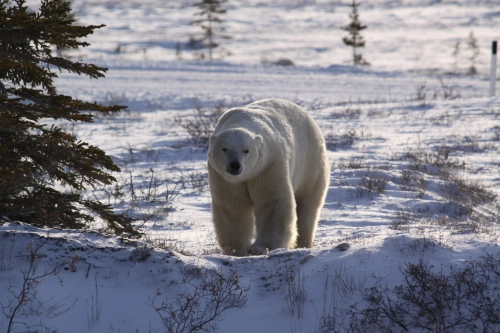
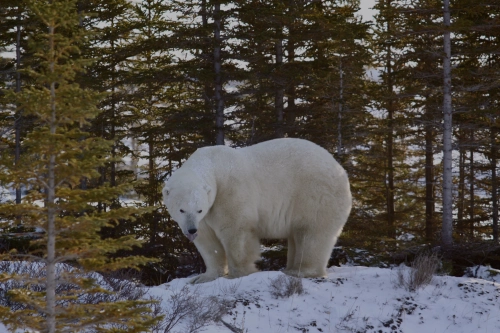
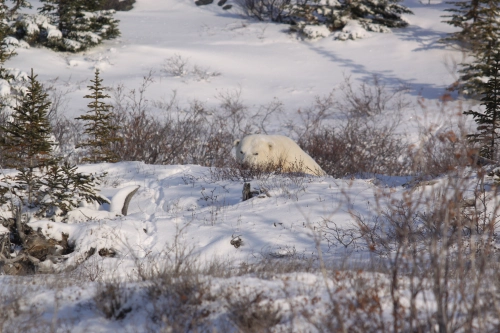
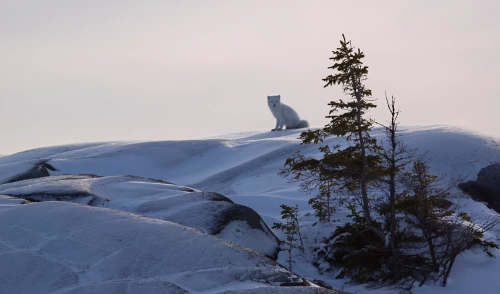
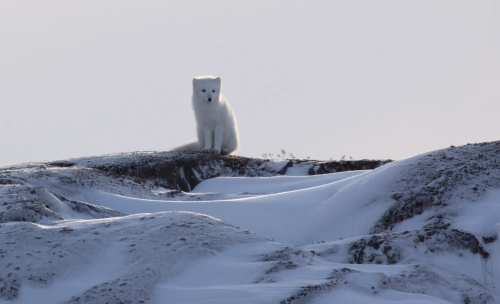
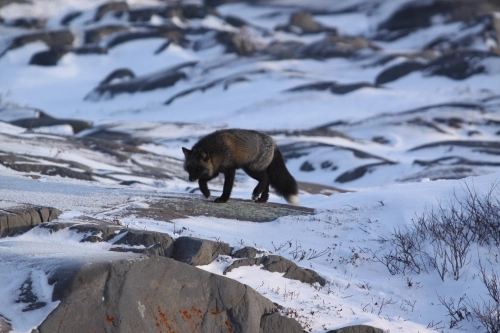
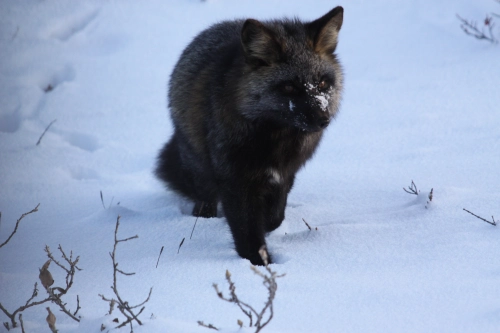
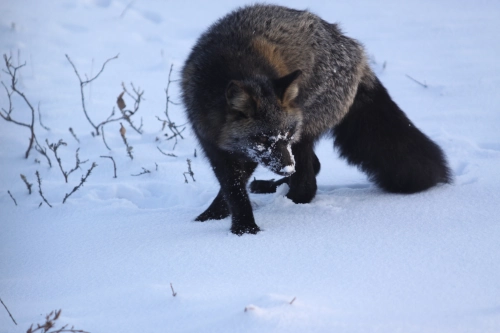
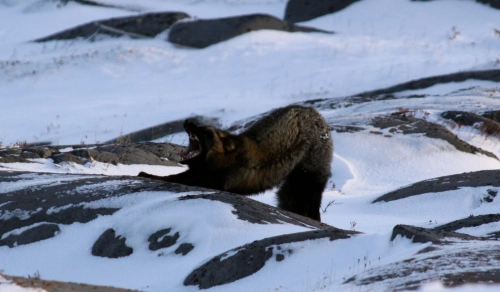
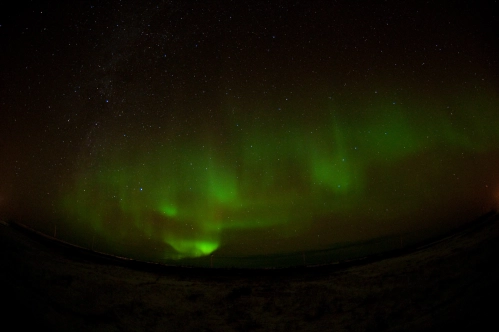
All photos taken by Colette Weintraub, except Northern Lights by Jeremy Beheler
November 11, 2009
Churchill
The pictures say it all. Another amazing day in Churchill.













All photos taken by Colette Weintraub, except Northern Lights by Jeremy Beheler
Posted in Polar Bears
Tagged Arctic Fox, Churchill, Cross Fox, Polar Bears, Red Fox, Silver Fox
November 10, 2009
Churchill
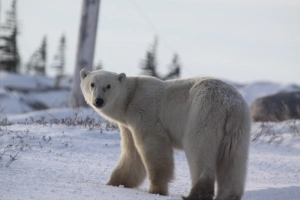
The third polar bear I saw today
I wish I could describe the feeling I get every time I see a polar bear. The polar bear is one of the most magnificent animals I’ve witnessed in its natural habitat. The weather was perfect for spotting bears today and the bears were quite active. It’s been one year since I last saw the bears of Churchill and seeing our first polar bear today made the small Arctic town feel like home.
The picture of the bear to the left is actually the third bear I saw today. The first one was out near some Tundra buggies, moving away from the vehicle and the group of people trying to catch a glimpse of him. I did capture a picture of that bear, but it’s at quite a distance.
The second bear I saw today was lying peacefully along the horizon. We observed him for a while. He was huge and didn’t budge an inch. He was also quite far away, but I’ll include a picture of him below because it gives a sense of his size.
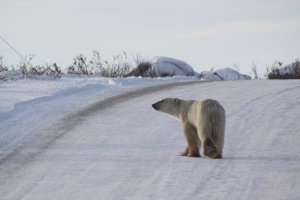
Polar Bear walking up the road
The third bear we came across actually came across us. He was crossing the road we were driving on. Ironically, we were looking to the right, toward the bay, in the same direction we’d seen the other bears. “There’s one on the road ahead of us,” somebody in our group called out. It was a classic case of looking for something and not seeing what is right in front of you. We slowed the bus and watch the handsome bear walk up the hill, along the road. He was a really cool bear. He’d take a few steps, look at us to let us know he knew we were there, and then keep on walking. It was just about dusk, and as the sun was approaching horizon, the bear seemed to be appreciating the setting sun. Eventually the bear made his way down the hill, behind some rocks, and we lost sight of him.
The next bear we saw was also crossing the road. This bear was running from some trucks that were following (or perhaps chasing it). Once the bear crossed the street, the trucks stopped to take photographs. We were told people may have been trying to move the bear away from some sled dogs. The Arctic is a strange place – it’s mysterious. It’s easy to jump to conclusions and think you saw something, but ask a few people and you’ll hear as many different perspectives as people you asked. Sadly, a bear was killed today (further North than where we are). The hunter and his grandson say it was self defense. We’ve also heard that they were out hunting, with the intention of killing a bear. Another person said the news reported that the grandson got stranded on sea ice, with a mother bear and her two cubs for a couple days. That doesn’t sound quite so innocent to me. I cannot imagine how or why people hunt polar bears.
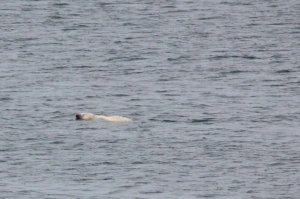
Swimming Polar Bear
Thankfully, this bear crossed the road and realized everything was okay. We saw the bear looking out at the water and looking back at us. Then, the bear seemed to disappear. We traveled a bit further down the road, rounded a corner and saw something I’d previously only seen on TV — the bear was swimming.
We looked at his fresh tracks in the snow and watched the bear swim for a while.
We saw several more bears walking across the tundra, and down through the trees. Then, we saw a spectacular sunset and called it a night. . . almost. . .
As I sat here writing this, a few of us on the late-night shift heard the Northern Lights were out. We quickly grabbed our boots and ventured outside again, this time in our pajamas. Before we left the building we looked left, right, up, and down to make sure there weren’t any bears hanging around the door. We sat in a vehicle, watching the glowing green lights in the sky morph and change shapes before our eyes. This is the second time I’ve seen the Northern Lights (the first was from the train last night) – a perfect bookend to an amazing day. Just before we headed back to the Center we saw a shooting star among the Northern Lights.
Here are a few pictures from today:
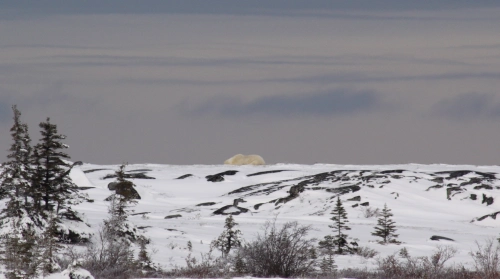
Bear on the horizon
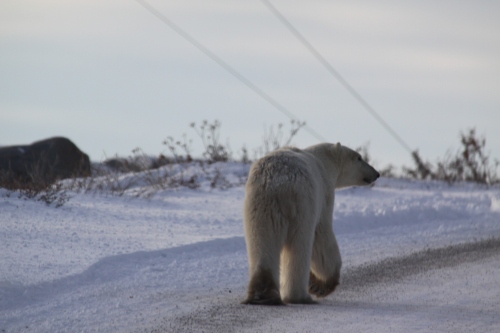
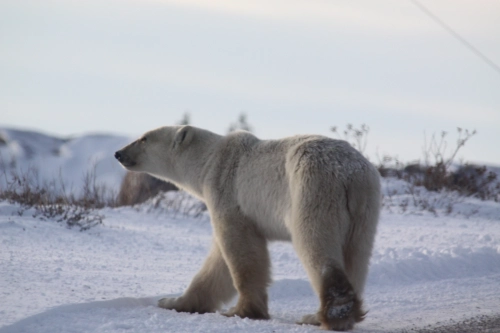
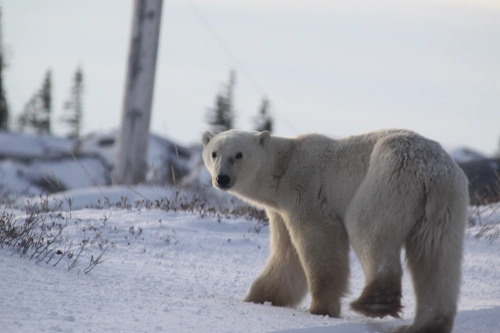

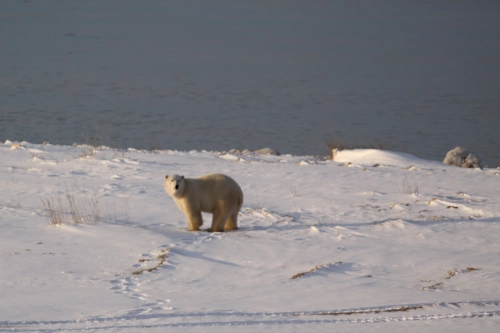
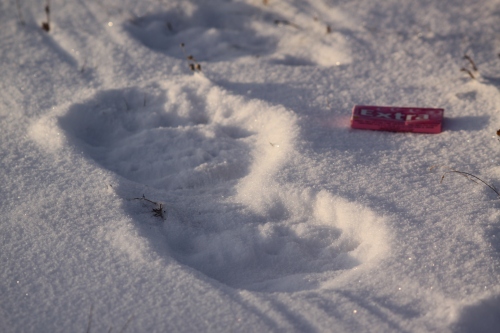
Polar Bear Tracks (next to a pack of gum for perspective)

Sunday, November 8, 2009 – Tuesday, November 10, 2009
Train from Winnipeg to Churchill
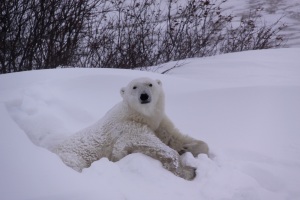
One of the polar bears I met in 2008
When I returned from Churchill last November I knew I’d go back. . . someday. Last year’s trip was an extraordinary adventure that allowed me to come face to face with the amazing white bear. My first Arctic expedition was sparked by a haunting dream that I was sitting with the last polar bear on Earth, trying to figure out how to save him.
My chronicles of adventure, stories about the bears, lessons about Arctic Ecology, and pictures were featured on MySpace’s OurPlanet for a month following my trip. I partnered with MySpace to help raise awareness about the impact climate change is having on the Arctic region and the polar bears, through my personal account and eye-witness experience. My inaugural journey is detailed earlier on My Travel Tales.
What I found following that adventure is that everybody I spoke with – friends, family, colleagues, strangers on airplanes – was extremely moved by my stories and pictures. We all hear about climate change. Most people are aware of it. Some people refuse to believe it. We hear about it on the news. People like Al Gore and organizations like Stop Global Warming make sure we have access to the latest information and tips about what we can do to help. But for most people, the effects of climate change and our individual and collective responsibility for it, remains one-step removed. It’s far more impactful when somebody you know, even if you’ve just met them, can share a first-hand experience with you.
For this reason and because I fell in love with the polar bears and the amazing scientist and his team with whom I traveled, I knew I would be back. However, I thought perhaps I’d return in 2010. The world is large and I’d like to see as much of it as possible, so I often don’t do repeat visits when traveling abroad. I knew I’d return to Churchill just as I know I’ll return to Bali, but this journey came more quickly than I expected. In fact, as November approached and I was feeling disappointed that I wasn’t going on the sold-out trip, I received an email from Shannon at The Great Bear Foundation: “We’ve had a cancellation. You’re first on the wait list.”
I’m doing the trip slightly differently this year. Last year I met the group in Missoula, Montana for a 24-hour bus ride, followed by a day and a half on train. I highly recommend that route for first-time travelers because you get more time with Chuck Jonkel, the scientist who’s headed up this trip for 25 years. As you make your way up to La Pas from Missoula, he points out the vegetation and wildlife and signs of climate change along the way. He also teaches you about bears and has some amazing stories to tell. It’s also a great way to get to know the group of fellow adventurers. Most of the people who embark on this journey are word travelers and conservationists themselves and they have amazing stories to tell as well.
This year, I picked up the train in Winnipeg. There’s an extra day on the train but it’s far more comfortable than the bus ride. Chuck and the rest of the group are scheduled to meet up with us and board the train sometime in the middle of the night. As with last year, I embarked on this journey alone. As with last year, I’ve already made some good friends. Although I should know better by now, it always surprises me how quickly a trip like this can turn complete strangers into a distinct family unit.
In addition to the bears, Arctic fox, Arctic hares, Northern Lights, hot chocolate and other wonderful experiences this trip offers, it forces me to get out of my daily routine. It broadens my perspective more than many trips I’ve been on precisely because the people on this trip are all making the long journey together, with the passionate desire to see polar bears and observe their behavior in their natural habitat. People on this trip come from diverse backgrounds, the majority of them do everything they can to avoid large cities. So the conversations alone allow us to connect about things that are different from my day to day. Traffic, the internet, going out late to see live music – these topics don’t arise in conversation. Grandchildren, forests, wildlife, ecology, biology, and books are commonly discussed.
Monday, November 9, 2009
It’s now Monday morning. Sometime in the middle of the night, Chuck, Shannon, Bob, Frank, and Jenny from The Great Bear Foundation boarded the train, along with the rest of our group. They met us in La Pas after driving for 24 hours from Missoula, Montana. Ordinarily, I might have been less-than-thrilled to be awoken shortly after finally falling asleep, but when I opened my eyes and saw my old friends, I couldn’t have been happier. Unless you’re in a sleeper car, it takes a while to settle into a comfortable sleeping position on the train. In my case it had taken 3 hours to get just comfortable enough, so before I jumped up to hug my friends from The Great Bear Foundation, I made note of how where my head, legs, back, and feet had been perfectly sandwiched in the seats.
After hugs and “hellos,” we stayed awake and caught up for a bit. We reminisced about stories from last year, which included 30-below weather and some unruly (and exceptionally fun) behavior on the train. Chuck also told us stories of his various haphazard adventures, “Only the incompetent have adventures,” he said with a chuckle. “The weather’s been nice so far – I don’t see why it can’t stay nice another few days,” Chuck noted before heading back to his sleep. Reunited with our group and a day closer to seeing polar bears, it was easy to fall back asleep.
When I awoke this morning, the sun had just risen and was reflecting off of a lake on our right. I noticed that a good portion of group was no longer in our car. “Where is everybody?” I asked Shannon, clearly not awake enough to realize they couldn’t really be far. People had started to make their way to the dining car for breakfast. Shannon and I joined them for the next seating and continued to catch up. Even the merging of the two groups of travelers – Missoula and Winnipeg – was effortless. Two became one overnight and now we have our polar bear family.
We’ve got another day on the train and are scheduled to arrive in Churchill at 7:00am Tuesday. “What are you going to do?” a nice woman named Anya asked after breakfast. “Y’know – sleep, read, and write . . .” One down, two to go.
Tuesday, November 10, 2009
Time on the train passed quickly on Monday. As we moved North from La Pas toward Churchill we picked up some commuters from the tiny villages along the way. The locals were going into the next “town” to do their regular (possibly only once monthly) shopping. The train only passes through every 2 days, so going to the grocery store is a 48-hour commitment.
But passengers continuing on to Churchill had one thing on their mind: polar bears. As we pulled into the Churchill station just after 7:00am, we saw several fresh polar bear tracks and a lot of fresh fox tracks. We also saw an unidentifiable dark brown or black animal heading East, away from the train. It was either a fox or a wolverine (a few had been spotted just off the side of the road at about that same time.
We gathered our luggage as quickly as we could, loaded up the vehicles, boarded a bus, and headed for the Research Center that we will call home for the next few days.
To be continued. . .
September 17 – September 22, 2009
Where have I been?! The lack of updates here has not been for a lack of travel. However, all of my travel this year has been within the Contiguous United States, much of it surrounding live music events. I’ve been to Austin for SXSW, New Orleans for JazzFest, Michigan for Rothbury Festival, Santa Barbara for Nine Inch Nails – you get the picture. As a result of all of this “music travel” and my desire to write frequently, I started an additional blog: Rock Is A Girl’s Best Friend. While not chronicling my travel tales, I have been blogging about my live music experiences.
Also, last year’s epic trip to visit the polar bears in Churchill is a hard one to follow-up! Little jaunts to San Diego, Palm Springs, and Seattle seem trite compared to that adventure. (I am highly considering a return visit to Churchill this year, so stay tuned for that.) However, last week I made a journey to Kauai that was so unique it felt like I traveled to another country.
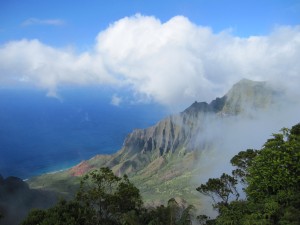
Kalalau Valley
Perhaps this trip won’t be considered all that unique for some people, but it was definitely different for me. During previous trips to Kauai, I was always accompanied by my parents, and a bit too young to appreciate all the intrinsic beauty and the “joy of doing nothing.” Well, all of that’s since changed!
I’ve been to Oahu and Maui as an adult several times. They’re nice of course, but they feel a bit commercialized. In fact, during my last trip to Maui, we weren’t able to visit the waterfalls unless we paid for an escorted tour. I asked a local about this, “C’mon – you know where there are waterfalls we can explore on our own. . . ” To my surprise the local man responded, “No, actually, the waterfalls here are on private property. The only people with keys to the properties are the property owners and tour operators. My friends and I tend to march to our own beat which can make group tours a bit of a challenge, so we skipped waterfalls during the Maui trip a few years back. We made up for it this time!
We also hit up some secluded beaches. So secluded that sometimes we were the only ones there. In addition to the absence of my parents, what made this trip unique is that I was guided by a local and both of us are quite adventurous. By “adventurous” I mean: if my parents would have advised against it, we did it. I’m not talking about jumping out of planes (although, that’s already on the itinerary for the next visit), but we did climb fences, traverse unkempt trails barefoot, and ignore “Danger” signs. All with great reward. . .
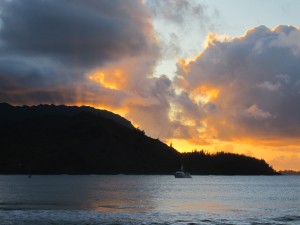
Sunset over Hanalei
I landed late Thursday afternoon and after a quick stop for lunch we headed straight to the beach. The first beach we hit up was Hanalei, home of Puff The Magic Dragon. The water was calm and warm, and the clouds looming above exacerbated the magical feeling that overtook us. We ended up swimming in Hanalei until just after sunset. Next, we enjoyed a relaxed dinner outside, at a nice restaurant on the North Shore. We went to bed fairly early (although it was 3-hours later by my Pacific Time) so that we would be ready for Friday’s adventures.
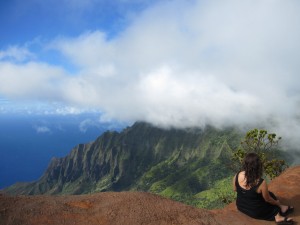
Sitting on the edge of a beautiful world
Friday: We got an early start, loaded the tent and sleeping bags in the truck, and headed for Small Tall Town Coffee, a great local shop in Kapaa. In addition to making the perfect Mocha, they also had delicious fresh honey spreads. We picked up the recommended toasted almond & honey spread – the first item in the cooler for our upcoming night of beach camping.
After coffee, we went to a great local’s diner and had eggs and their signature Tropical Shorty pancakes with coconut syrup. Yummmm! The places we ventured were not crowded, not your typical tourist stops, and in some cases unmarked or difficult to find – all of which made this trip even more spectacular. We dined, hiked, and swam with the locals, never waiting more than a few minutes for any experience. I’ve been asked not to post the names nor locations of some of the places we went, since part of their allure is that they are well-kept secrets and among the few places locals can visit to escape the hustle of tourists.
After breakfast we picked up food, firewood, and supplies for what would become a night of mystical beach camping. With all our gear loaded in the truck, we headed south so we could get a view of Kalalau. Originally, we discussed hiking the 11-mile trail some describe as treacherous and camping out at Kalalau. However, there weren’t enough days during this vacation to work that in, so we decided to appreciate the magnificence of Kalalau from above.
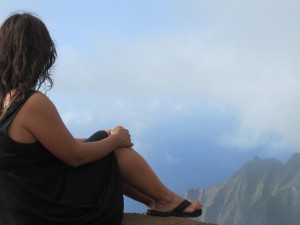
Sitting on the edge of the Earth, way above the Ocean
We spent a while taking in the views. I found it interesting that the designated “viewing areas” were well gated and secured, but if you continued to the end of the road, you could walk down a path and literally dangle your legs off the edge of the earth. People watched us do it as if it were no big thing. . . until they got closer to the edge and saw the vertical drop. Then, without fail, after an audible gasp, the men on the path would tease their wives and travel companions by getting as close to the edge as possible.
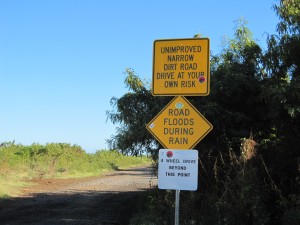
Entrance to Polihale
Next, we began the journey to Polihale. Polihale is one of those local gems, but you need to have 4-wheel drive and be willing to drive at least 5 miles over rocky, ditch-ridden, unpaved roads in order to get there. I never saw any signs or arrows pointing to this beach and in fact, several of the roads we were on were unnamed (or rather, their names are not designated by signs). Important to note – you can camp on the beach at Polihale. But you can also drive on the beach at Polihale. So if you plan on camping on the sand, be sure to make yourself visible by building a camp fire or making a compound around your tent. We saw several huge trucks traversing the sand throughout the night (mostly used to get from one side of the beach to the other than obnoxious joy riding).
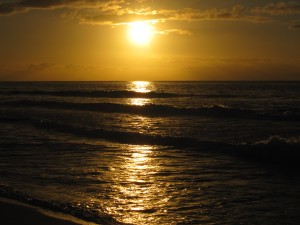
Sunset at Polihale
Polihale means “House of the Po”, and Po is the Hawaiian afterworld. It is believed that this is the place spirits come before they “move on” by jumping into the sea. Whether or not this is true or Hawaiian lore, there is definitely something mystical about Polihale.
We arrived just prior to sunset and waited for the sun to sink below the horizon before we set up our tent. Once the sun set, we built a campfire to provide light while we got situated. There were approximately six other groups of people camping on the beach, but everybody was substantially spread out. Aside from the flickers of light bouncing off one of the campfires, all you could see were stars. And because there were no obstructions (buildings or lights), the stars appeared visible from the ground behind us, all the way to the horizon.
What’s there to do with a campfire, but make S’mores?! We perfected and ate S’mores, listened to one group of campers have a sing-off (which sometimes morphed into a sing-a-long), wished upon shooting stars, and drifted off to sleep. While sleeping under the stars at Polihale I experienced some of the most magical dreams yet. They felt larger than life and exceptionally colorful – a bit like being in a fairytale. When I awoke it almost felt like I never went to sleep because my dreams were so active and the “characters” so unique.
Saturday: We watched the sunrise at Polihale, packed up our gear and decided to head back to the North side of the island for more adventures. But first – breakfast, of course. I don’t remember the name of that diner either, but it was a really cute place with its own bakery (which made for an exceptional breakfast croissant). We sat outside, leisurely sipping our coffee and discussing the day’s plans.
The thing about Kauai is that “plans” are extremely loose. Conversations go something like: “Should we go to a waterfall, take a nap, or go swim in the ocean?” While it’s entirely possible to accomplish all of those things in one day (and we did), there’s no need to commit to a “plan” in Kauai. You can truly just go with the day and see how you feel, which leaves more room for spontaneity and adventure.
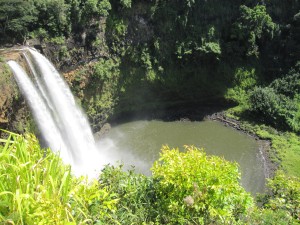
Wailua Falls
On the way back from breakfast, my friend took a sharp left off the main road toward Wailua Falls. As with most things that are worth seeing in Kauai, you must first journey along a narrow, winding road. I got used to the drives pretty quickly — anything was easier than that road to Polihale. We arrived at one of the Wailua lookouts and viewed this 80 foot waterfall from above. It was spectacular, but what really caught my eyes was the beautiful body of water and river below. The waterfall came thundering down into the most peaceful pool of water, and nobody was in it! “You used to be able to climb above the waterfall,” my friend explained, “but people have fallen and died, so they closed it.” Sure enough, there were gates and huge “DANGER” signs posted all along the perimeter.
“I don’t care about going above it,” I replied, “I want to go down there – I’d like to get IN it!”
My friend explained that this wasn’t possible. There’s no way down. When I later recounted this story to another friend she said, “Wow. . . Ali must have forgotten who she was with. You always find a way. . .” Ignoring Ali’s suggestion that a trek to the base of the waterfall was not possible, I began surveying the area closely. Within minutes I saw people with inexplicably muddy feet and wet clothing.
“Look at them!!” I said to Ali. “They’ve been somewhere wet and muddy – they’ve been down to that waterfall!”
“Maybe they came from somewhere else. Look – there’s no way down,” Ali said, pointing all around us.
We continued walking up the road and ran into a local, Phill, whom Ali knew. Phil was selling handmade wooden instruments at the top of Wailua Falls. We chatted with him for a bit, played around on the instruments and then I pointed to the bottom of the falls and asked, “is there a way to get down there?”
“YES!” Phil’s face lit up as he explained, “If there’s one thing I tell people to do in Kauai, it’s hike down to the bottom of this waterfall. You can even go behind it.”
“Great! How do we get down there?” I inquired.
“Follow this road around the bend. You’ll see a place where people have pushed down the fence. Go over the fence and start walking down the path until you get there.”
“Can we wear these shoes?” I asked, pointing to our flip flops.
Phil chuckled. “Don’t wear any shoes,” he offered helpfully. “It’s really muddy and slippery down there and shoes get stuck and break. There are a lot of broken shoes down there. Go barefoot and grip the rocks and dirt with your feet.” And with that, we walked back to the car to ditch our shoes.
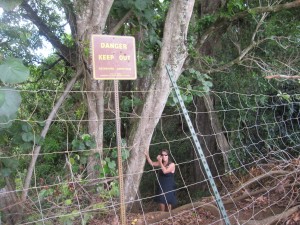
You've been warned
[Now, as with all adventures recounted in this blog, these are my personal stories, not my recommendations for you. While I find these experiences extremely rewarding, I’m not suggesting that you go beyond your comfort-level, trespass, or endanger yourself in anyway.]
We took off our shoes, drank some water, and headed barefoot back down the road toward the man-made “entrance”. We were greeted by a Danger. Keep Out sign and a lot of mud. We stepped over the portion of fence that had been pushed down and carefully began to navigate our way down the hill. The no-shoe suggestion was very helpful! Tree roots became the make-shift “steps” down the hill as we wound our way over and under branches, trees and bushes. Some locals have put rope along the way which helps mark “the path” and can be used for additional stability when you’re making your way to the waterfall.
“Getting back up there is going to be interesting,” Ali said, after we had been walking for a little while. Having not thought about that previously, I looked up at the steep, muddy hill behind us. “So that’s what the rope is for! That’s going to be even more useful on the way up,” I replied.
We continued down the way until we arrived here:
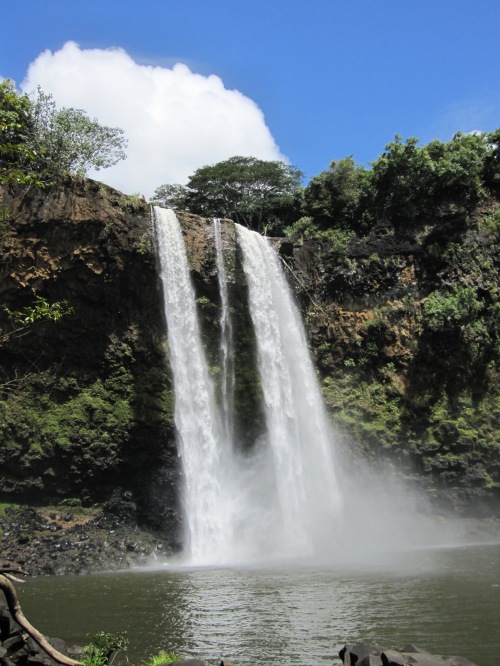
We made it to the bottom!
Yes, it was worth it. And extremely gratifying.
We swam around freely in the pool beneath the waterfall. At one point, I floated on my back and looked up at the forceful stream of water pounding down beside me. If only I had a waterproof camera – it was one of the most spectacular sights I’ve seen. There are few things more humbling than swimming around waterfalls. There were two people heading out when we arrived so we had the falls to ourselves for a while. Then, gradually, a few more people tentatively made their way down to the falls.
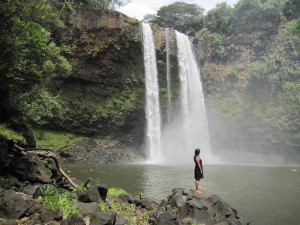
Standing at the base of the falls
After soaking it all in for a while, we decided it was time for the next adventure. The ropes tied between the trees were essential to scaling the mountain on the way back up. It was also helpful to just look where your feet were stepping, one step at a time, rather than look up. . . or down! When we got back to the road we paused for a moment of gratitude, thanked Paul for his guidance, and walked back to our car.
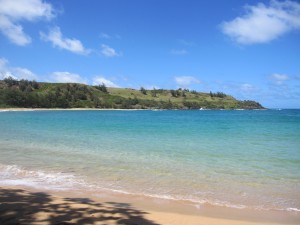
"Just sit right back and you'll hear a tale. . . "
Ali didn’t tell me where we were headed next. Actually, she did rattle off the names of 4 different beaches, but none of them were familiar to me. “Ok – it’ll be a surprise,” Ali said as she navigated us back to the main road. We drove for a while longer, made another sharp left turn (again unmarked) and ended up on a residential street. We parked the car and walked along the road until we could access the beach. And there we were – at the site where the first couple episodes of Gilligan’s Island were filmed (November 19 -22, 1963), Moloaa Bay. The water was pristine and the sand was fine and soft. We swam around in the crystal blue bay for a while and napped on the sand.
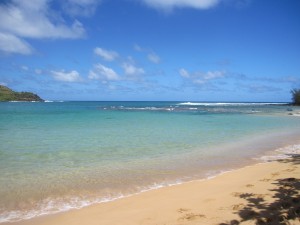
Not so sure being stuck on Gilligan's Island was a bad thing!
I honestly don’t remember what happened after that. I think we may have headed home, showered, and then went to a friend’s house for dinner. I do know that I slept exceptionally well on Saturday night.
Sunday: By this point, we had adventured, camped outside on the beach, swam in waterfalls, and enjoyed some good meals. Now was the time to do what I can only do in a place like Kauai – truly slow down. Stop even. We spent most of Sunday lying around the house, napping, catching up. We eventually made it out to a beach and went swimming at sunset and then picked up some dinner and went back to sleep. I got more sleep Sunday than I do cumulatively during a typical week.
Monday: Our day of rest behind us, it was time for more waterfalls. First, we walked to breakfast at a little local bakery. As usual, we sat outside, leisurely sipped our coffee, and considered our options for the day. We initially planned on snorkeling, but we checked the surf report and the water was going to be too rough for snorkeling. In fact, it was advised that people stay out of the water on the North Shore altogether on Monday (that of course doesn’t apply to the world class surfers who live for days like this).
So instead of snorkeling, we went on another waterfall adventure. Ali explained that there was a bit of a hike involved, but it would be worth it. I actually enjoy hiking so that was part of the fun for me, although I don’t typically hike in that kind of heat and humidity. I’d imagine the hike is a couple miles (1-3) each way.
First, you walk down this path for a long time:
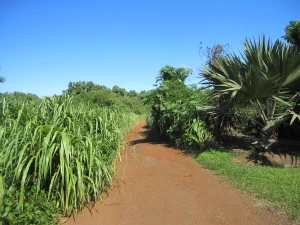
Then, you climb over this gate:
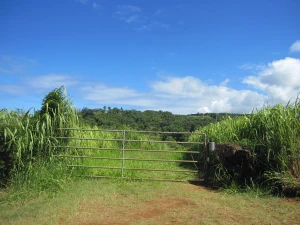
Next, you walk along this winding and hilly path for a considerable time:
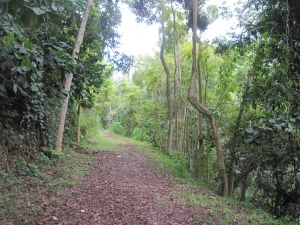
The scenery on this path changes drastically as you make your way along. At times it feels like you’re in the rain forest, other times it feels like you’re in the jungle, and due to the heat, sometimes it feels like you’re in the desert.
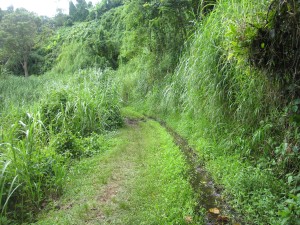
Eventually you get here and you see the first sign of water moving down a stream to your left:
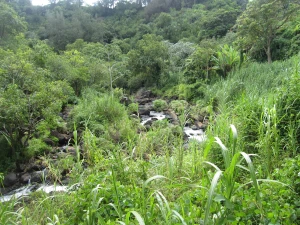
And then, you arrive here:
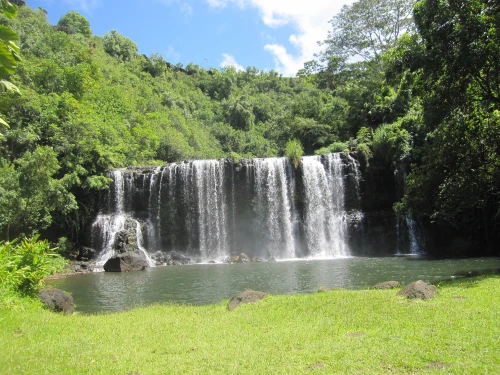
Next thing you know, you’re here:
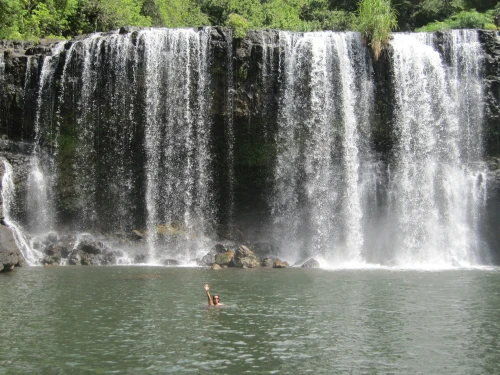
The waterfall swimming was amazing and once again, we were the only people there. One thing to remember about these falls is: after you get out, you still have the long, hilly, hot walk back. Even so (or especially so), it’s worth it!
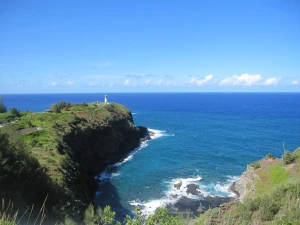
The Lighthouse
Once we made our way back from the waterfalls, we stopped by the lighthouse and wild bird sanctuary. The view – as I became accustomed to – was spectacular.
We wound down the evening and brought dinner home. I threw my wet clothes in the dryer and began packing.
Tuesday: At 4:30am the alarm went off. If you have to leave Kauai, I recommend you do it while it’s still dark out.
Tagged Beach, Camping, Gilligan's Island, Hanalei, Hawaii, hiking, Kalalau, Kalalau Valley, Kapaa, Kauai, Moloaa Bay, Polihale, Wailua Falls, Waterfall
It’s always an adjustment when the back-to-back travel ends and I find myself at home for an extended period of time (longer than a week or two). Putting the suitcase away and unpacking the toiletries is the final concession that I’m staying put for a while. . . NOW what do I do?
I try to get back into my daily routines: wake up early, go for a run on the beach, go to the office, have dinner with friends, go to a concert. It takes a while to settle in and I find myself missing the airplanes, taxis, new restaurants, different experiences, and meeting new people. It takes a lot of will-power to not just jump on the next plane to Kauai, San Francisco, or Vegas, or hop in the car and drive to San Diego (although any number of those things may happen within the next week). Thankfully, there’s plenty of adventure at home!
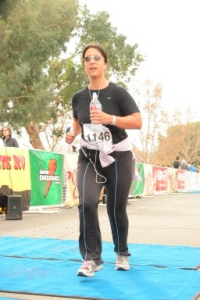
Mile 6
I’ve been home for 3 weeks now – quite possibly the longest stretch I’ve gone without traveling this year – and have had several fun journeys. It’s been a nice reminder that I can travel in my own city. Earlier this month I ran the Pasadena Half Marathon with my good friend, Jen. I haven’t been to Pasadena in years and forgot how simply going to another community can feel like a vacation! First, we ran through the beautiful tree-lined streets, passing by some magnificent homes. The colors of the leaves had changed and there was evidence that we actually do experience “seasons” in LA. It felt like we were in New England, only warmer.
The second third of the course was spent on dirt trails in the hills. You can truly get lost in the mountains and forget that you’re anywhere near a city. There was one hill that was long and steep. Most people walked it (myself included) and many were out of breath at the top. I couldn’t help but laugh when we arrived at the top of the hill to find a sign marked “Devil’s Gate.” We hit the pavement again for the last portion of the course. Crossing the finish line was fantastic because it signaled the end of the run… and the beginning of breakfast!
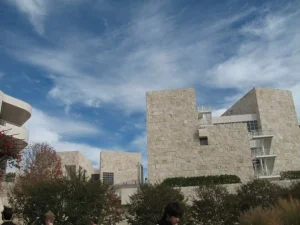
The Getty - sometimes it's too nice to inside!
The following weekend my friends Juston and Laura came to town. We spent a beautiful Sunday afternoon up at The Getty. Juston and Laura are both artists so I felt inclined to warn them that while we have every intention of going inside the museum, many visits to The Getty are spent entirely outdoors. They chuckled (perhaps in disbelief) and said, “well, of course we’ll go inside!” But we began our adventure outdoors, walking the gardens, admiring the way the buildings “framed” LA perfectly, looking at the ocean on one side of the property and snow on the mountains on the other side. We ate brunch and then attempted to go inside the museum. We were in one building for a few minutes, then another, and then Laura said,”you know, it’s so nice outside, I feel like we should be soaking up the sun!” And so, as most days at The Getty are spent, we ventured back outside, sat on the grass, watched kids roll down hills and scale walls, while we caught up and took in the view.
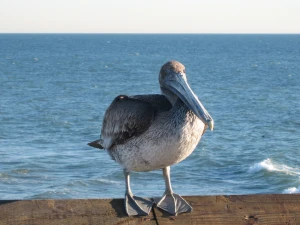
Sunbathing pelican in Newport
And finally, last weekend my friend Heather and I planned a mini-vacation. She lives in San Diego so we met in Newport Beach, half-way between Santa Monica beach and Mission Beach. We spent the day at the beach, bouncing between restaurants, bars, coffee shops, and bakeries, with outdoor seating. It was so warm and beautiful that we had to keep reminding each other that it was December 28th.
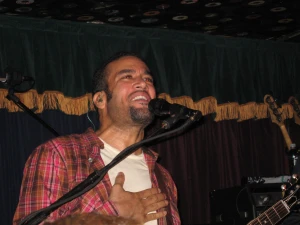
Ben Harper at The Mint, Hollywood
In between all of that was a bunch of live music. From Ben Harper at The Mint to Ozomatli at House of Blues, to Hotel Cafe family reunions and holiday shows. . . it’s been a non-stop adventure since I returned home!
Posted in U.S.
Tagged Ben Harper, Half marathon, Newport Beach, Ozomatli, Pasadena, The Getty
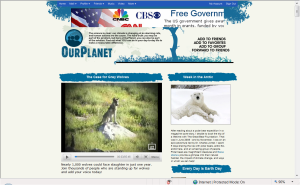
My Arctic Adventures Blog featured on MySpace
I woke up this morning to an email from MySpace – they’re featuring my blog on their Our Planet channel: http://www.myspace.com/ourplanet. Many thanks to MySpace for sharing these stories and helping spread awareness about polar bears and how we can all help preserve the Arctic region.
Also, big thanks to Chuck (Dr. Jonkel), Shannon, Matt and everyone at The Great Bear Foundation for the amazing experience and sharing their wealth of knowledge.
The main reason I spent 8 days on planes, buses, and trains, traveling to the Arctic was to experience first-hand the affects of climate change on polar bears and Arctic ecology. It seems awareness of climate change has increased and more and more people know that the survival of polar bears is threatened, but it can still feel like “a problem over there” — not part of our day to day consciousness. I don’t believe this is malicious, it just isn’t top-of-mind for many people, most of the time. I live in LA where it’s 73 degrees and beautiful almost every day of the year. It’s hard to expect everyone in LA to think about ice caps melting and polar bears heading toward extinction, on a day to day basis. People all over the world are consumed with their own survival, happiness, and daily responsibilities – global warming is not top-of-mind, even though they’re aware of it.
The thing to remember is that it’s all connected. The way we live, wherever we live, has an impact on the environment as a whole, which in turn has an impact on us. Dr. Jonkel (Chuck) reminded us that people are wasting time debating whether Global Warming is something people are causing or just “part of mother nature’s natural cycle.” He encouraged us to recognize that both points of view are valid – some of the climate change we see is mother nature “doing her thing” AND some of it is caused or accelerated by what we’re doing. All Chuck asked of us is that we help the part that we can control – the impact we have on the earth and the things we can do to minimize that.
Several groups have put together lists of simple steps to combat global warming in our everyday life. Stop Global Warming has a great list: http://www.stopglobalwarming.org/sgw_actionitems.asp
The NRDC is also doing work on climate change: http://www.nrdc.org/globalwarming/default.asp
Global Warming Solution is a Missoula, Montana based organization founded by a Great Bear alum. Their executive summary is really helpful:
http://www.globalwarmingsolution.org/pdf/Summary.pdf
Global Warming Initiatives, Inc is a really cool company that helps businesses to reduce their carbon footprint while at the same time saving money on energy efficiency:
The lists of simple steps are great in that they are easy to achieve and anybody can do things like switch to energy efficient light bulbs, etc. And if we get enough people to do these things, we can make a difference.
We can also support initiatives like the Western Climate Change Initiative:
http://www.westernclimateinitiative.org/
This is an alliance of seven western states and two canadian provinces working on ways to reduce greenhouse gas emissions.
We can pressure our schools, workplaces, and local and state governments to conduct greenhouse gas inventories, to determine how much impact they are having and how they can reduce that impact. It often saves money in the long run on energy costs.
The bumper sticker, “think globally, act locally” has never meant as much as it does today. The average meal travels 1,500 miles to our dinner plates, consuming fossil fuels for transport, processing, refrigeration, etc. One of the biggest changes we can make in our everyday lives is to buy locally, eat locally, and eat seasonally. By gardening or participating in CSA’s, we not only reduce the fossil fuels used to feed ourselves, but the plants we grow also help to produce clean air and to sequester carbon. Can or dry the extra food from your harvest, and you can eat your bounty year round. Grow squashes, potatoes, and other hardy vegetables that can grow late in the season and keep throughout the winter.
Chuck would say that one of the most important things we can do is to raise awareness of the polar regions. There are few people living up there, and their voices are rarely heard. Most people think of the north as a barren waste of ice. The more people learn about the Arctic, the more they will care about it. That’s the point of Chuck’s “Learning to Talk Arctic” lecture. As people become more familiar with the polar regions, they will care more.
I fell in love with polar bears during this trip. I stood 30 feet away from them and watched in awe as they played, searched for alternative food sources, and walked across the ice with power and grace. I think about them every time I put gas in my car or ask a business to turn off the air conditioning when it’s cold outside (and inside). I think about the collective positive impact we can have by taking simple steps in our own lives and educating (and sometimes pressuring) business owners to make positive changes. And then I do everything I can to help ensure the survival of polar bears and make a positive impact on the Earth.
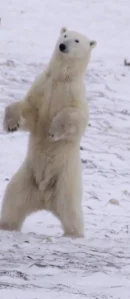
Curious Bear
For all the good times, defining moments, and magical experiences I’ve had (and there have been many), it’s always a blessing when another comes along. I just returned from a long weekend in Big Sur. It’s been tradition during the past 3 Thanksgiving weekends to drive up the coast and attend my friend Shiva’s yoga retreat. It’s something I look forward to every year. But this year, having literally just returned from back-to-back trips to the Arctic and Turks & Caicos, I actually considered not going. I wasn’t sure I felt up to more travel and was enjoying my time at home. I also felt completely relaxed and re-treated (or so I thought).
The town had one main street, only 5 blocks long. There was an old saloon and a restaurant that looked like a pirate ship. I ate lunch at the pirate ship restaurant, and sat on the upstairs deck outside, overlooking the ocean. The town was simple and charming – if I ever dissapear, it’s possible I took up residence there.
As I continued driving I noticed an Elephant Seal viewing area on the side of Highway 1. In the dozen times I’ve made this drive previously, I never noticed this turn-off. It’s easier to pay attention without the cell phone! I pulled over and checked out the elephant seals. They can weigh up to 2 tons and are NOT pretty animals. It was odd to see all these huge beasts lying on the beach – they looked almost prehistoric. There was one little, white seal who was loving the sun and appeared to be smiling as she scratched her head with her fin and then settled back to sleep – she was pretty cute.
Ambika, Joey, Kishan, Janet, Kristin, and I gathered in another room on the property, sat in a circle and caught up for a little while. We laughed and plotted our night’s activities – sleep was NOT on the agenda. After everybody else went to bed, the 6 of us returned to the hot tubs, reunited with our other friend Matt, and soaked for a couple hours. At about 2am Ambika and I went upstairs to the deck, pushed a couple massage tables together, laid down, and looked up at the stars. There were no city lights obstructing the view and so many stars that it almost looked like there was more light than darkness. And then we saw a shooting star. “Let’s count shooting stars!” I said and Ambika agreed.
Sunday was another beautiful day. It felt like summer, clear skies and warm – rare for late-November in Big Sur. We had brunch after yoga and then made our way back to the tubs. Our Sunday departure tradition for the past 3 years has been to spend the day in the tubs and leave in the evening after most of the holiday traffic has died down. At one point Daphne and I were discussing options during Labor Day weekend 2009 – Burning Man, Spirit Bear trip in British Columbia, or a trip to the South of France. “Well, it’s a win-win-win decision,” I said.
Another great part about the weekend was this place on the property where somebody left messages written with rocks. The messages were updated several times daily. They were messages written in stone, yet not “written in stone.” And if you didn’t pay attention, you may miss a subtle change. It said “Like fixes like” for a few hours one day and then it switched to “Life fixes life.” The night we did our stargazing, the sign said “Starlight” with an arrow pointing over the ocean. You could never take for granted that the sign would be the same and you never knew when it would be updated. There was no “schedule” that sign changed and it may have changed more frequently than we even observed. Nobody saw the sign being updated (even in broad daylight), it just seemed to “happen” and the message was always perfect. As I was leaving Sunday, the sign changed again. “I’ll miss you”
Mid-way through our stay in Churchill we discovered that Ian Stirling was coming to town and would be giving a lecture on polar bears and climate change the night we were scheduled to return home. This was one of those moments you’re thrilled that your train is 7 hours delayed! Ian Stirling is a renowned scientist who has been studying polar bears and Arctic ecology for more than 30 years. Thanks to train delays, we were able to attend Ian’s lecture. When Ian saw Chuck in the audience he told a story about how Chuck once led him into a bear den… while the bear was still in the den.
Here are some video clips (2 parts) of the lecture. These are some general facts about polar bears, their reproductive cycles, and their place in the food chain.
Ian Stirling Lecture Part 1
[Youtube=http://www.youtube.com/watch?v=oXfw2G9-_3U]
Ian Stirling Lecture Part 2
Posted in Polar Bears
Tagged Arctic, Churchill, Climate Change, Ian Stirling, Polar Bears, Ring seals
These videos were taken during our second to last polar bear outing. Prior to this day, it was 20-30 degrees Fahrenheit which was too warm for the ice to form and move to the shore of The Hudson Bay. Polar bears rely on this ice so they can go out and hunt. Thankfully, as we were leaving Churchill a cold storm moved in. Locals were enthusiastic and hopeful that this storm would finally bring the ice to shore so the bears could eat. The bear’s hunting season is getting shorter each year – the ice shelf forming later and breaking up an average of 2-3 weeks earlier than it used to.
The first video shows a polar bear seemingly walking with a destination in mind, but he stops for a playful time out before continuing on his way.
The next video shows a bear shielding himself during a windstorm and 19 degrees below temperatures!
We only saw one mother bear with a cub during our trip. And days when we saw 8 bears, we should have seen 20-30 bears according to Dr. Jonkel (“Chuck”) who has been leading this trip for 25 years. Chuck made sure we understood this is not a good sign. It’s not only further evidence that the polar bear population is decreasing, but indicates that reproduction is decreasing as well.
So, what can we do? That’s coming next!
Posted in Polar Bears
Tagged Arctic, Churchill, Climate Change, global warming, Polar Bears
Several people have asked where I was, geographically, during the polar bear trip. It’s hard for most people to picture how far North we were. Our location in Churchill, Manitoba (on the Hudson Bay) is important because this is where the ice forms earliest. The bears rely on the formation of the ice shelf so they can go out and hunt. So the bears come here first to await the formation of the sea ice. It’s also important because there are some pending international decisions that affect this region. Here’s a map to give a better sense of where we were and how this plays into foreign policy that affects the polar bears:
On the evening of November 12th, following a day of Arctic adventure and spotting bears, Dr. Charles Jonkel (“Chuck”) taught us about the relevance of where we were sitting and some critical changes and decisions that will affect the polar bears.
Chuck explained that the Polar Basin is actually quite small. We need to do more than we’re doing now to preserve the ecology here. We need to increase awareness and let people know how to impact positive change. The polar bear is particularly vulnerable. It’s a rare example of a terrestrial animal that lives on a food source under the ice – the ringed seal. The polar bear is an animal that depends on 2 totally different environments to survive, which makes it vulnerable in 2 ways: threats to its environment and threats to the environment of its food chain.
Chuck spoke about the crucial stretch of the Northwest Passage, which was blocked for 65,000- 100,000 years with old ice, unusable. About 15 years ago Americans discovered the Northwest Passage. Canada claims the Northwest Passage (including Hudson Bay) belongs to them, but this is in dispute with other countries that border these waters including America and Russia. The ice in the Northwest Passage melted out 3 summers ago, bringing Asia and North America 2,000-4,000 miles closer (because now we can cut straight through, instead of having to go around). This will have a huge impact on shipping industries, importing and exporting. Now there’s major money involved and countries are battling over this region. There are no treaties governing the area yet, but they will be written and countries will be fighting for control. It’s important that we understand the politics at play here because the countries that border this region will have tremendous impact on the Arctic ecology (for better or worse).
Other information Chuck shared with us during this lecture are:
Chuck suggested we continue to learn about this region and pending policies that impact it. He prompted us to write letters to the Russian and Canadian governments. If nothing else, LEARN about it. Chuck said the reason he was “teaching us to talk Arctic” is because when people hear something they don’t understand, they tend to tune it out. He wants us to be familiar with the region, the terminology, the animal and plant life so that we can participate in the discussion.
Posted in Polar Bears
Tagged Canada, Churchill, Climate Change, Education, global warming, Hudson Bay, Polar Bears